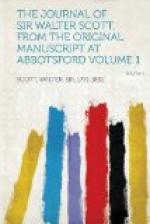To me thy tedious feeble pace Comes laden with the weight of years; With sighs I view morn’s blushing face, And hail mild evening with my tears.
_—Life,_ vol. i. pp. 334-336.
[71] Sir William Forbes crowned his generous efforts for Scott’s relief by privately paying the whole of Abud’s demand (nearly L2000) out of his own pocket—ranking as an ordinary creditor for the amount; and taking care at the same time that his old friend should be allowed to believe that the affair had merged quietly in the general measures of the trustees. In fact it was not until some time after Sir William’s death (in the following year) that Sir Walter learned what he had done.—Life, vol. ix. p. 179.
[72] St. Valentine’s Day or Fair Maid of Perth.
[73] A Royal Commission, of which Sir Walter was a member, had been appointed in 1826 to visit the Universities of Scotland. At the suggestion of Lord Aberdeen, a hundred guinea prize had been offered for the best essay on the national character of the Athenians. This prize, which excited great interest among the Edinburgh students, was won by John Brown Patterson, and ordered to be read before the Commissioners, and the other public bodies, with the result described by Sir Walter. It was read on the 17th November before a distinguished audience.
[74] Sir William Rae’s house, in Liberton parish, near Edinburgh.
[75] From the old song Andrew and his Cutty Gun.
[76] Sir James Gibson-Craig, one of the Whig leaders, and a prominent advocate of reform at the end of last century.
[77] Gillespie was tried at Aberdeen before Lord Alloway on September 26, and sentenced to be executed on Friday, 16th November 1827.
[78] Slightly altered from Macbeth, Act II. Sc. 2.
[79] Lady Elizabeth Montagu, daughter of George Duke of Montagu.
[80] Saladin’s shroud, which was said to have been displayed as a standard “to admonish the East of the instability of human greatness.”—GIBBON.
[81] The belief in the existence of the ‘Water Cow’ is not even yet extinct in the Highlands. In Mr. J.H. Dixon’s book on Gairloch, 8vo, 1886, it is said the monster lives or did live in Loch na Beiste! Some years ago the proprietor, moved by the entreaties of the people, and on the positive testimony of two elders of the Free Church, that the creature was hiding in his loch, attempted its destruction by pumping and running off the water; this plan having failed owing to the smallness of the pumps, though it was persevered in for two years, he next tried poisoning the water by emptying into the loch a quantity of quick lime!!—Whatever harm was thus done to the trout none was experienced by the Beast, which it is rumoured has been seen in the neighbourhood as late as 1884 (p. 162). This transaction formed an element in a case before the Crofters’ Commission at Aultbea in May 1888.




